Once you start going down the rabbit hole of making your own homemade cleaning products, you won’t want to stop. This homemade laundry detergent definitely needs to be next on your list. It’s so simple to make, only requires 3 ingredients, and is far more cost effective than store-bought laundry detergents. Not only that, but this recipe is fully non-toxic. Keep reading to learn how to make the best homemade laundry detergent!
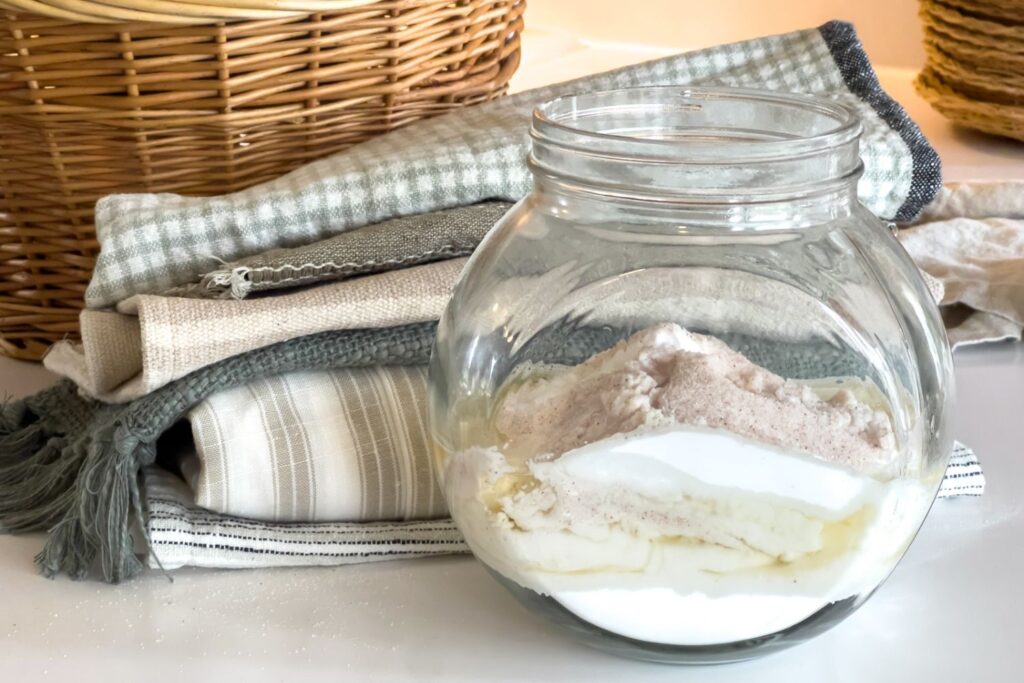
Why Make Homemade Laundry Detergent
I’ll admit, years ago I switched to an all-natural laundry detergent, and I felt good about it because it didn’t have the artificial fragrances and toxins that other store-bought detergents did. However, I recently discovered that I still never truly read the label to see what the actual ingredients were. And while they were mostly non-toxic ingredients, some of them can still be irritating to the skin, and it would definitely be toxic if accidentally swallowed or inhaled. This led me on the journey to learn how to make homemade laundry detergent, what common ingredients there are, how they work, and how safe they really are.
Why These Ingredients
Baking Soda
Sodium Bicarbonate, also known as baking soda, is a wonderful all-natural household cleaner, and it is used in a variety of cleaning (and baking!) recipes. It is alkaline (soap-like) on the pH scale, making it a great laundry detergent ingredient for neutralizing odors, softening water, and removing stains.
Sea Salt
Sea salt works to remove stains and keep the coloring in clothes from bleeding into other pieces of laundry. It’s also a wonderful cleaning and scrubbing agent that boosts the overall effectiveness of the detergent.
Liquid Castile Soap
Castile soap is wonderful at cleaning and washing away dirt and grime. It’s degreasing as well, which helps to lift greasy spots out of clothing. Adding a liquid Castile soap to the recipe rounds out the overall potency and effectiveness of this homemade laundry detergent recipe.
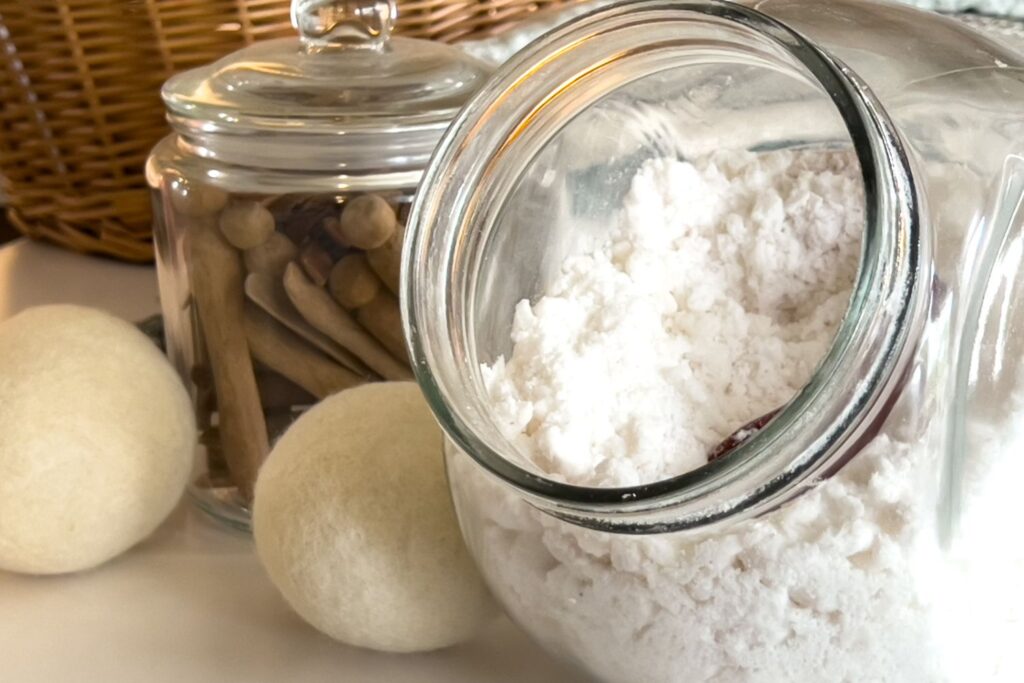
Why Leave Out These Ingredients
No Washing Soda
Sodium Carbonate, also known as washing soda, is a naturally-occurring in-organic compound. Though sodium carbonate (washing soda) and sodium bicarbonate (baking soda) have some similarities, they are molecularly different than each other, and have different chemical properties. One of the reasons that washing soda is not quite as safe as baking soda is because it is higher on the pH scale.
Unlike baking soda, washing soda can damage the surfaces of your clothes over time, fade colors, and eat away at delicate fabrics. It is also recommended to wear gloves at all times when working with washing soda, because it can cause chemical burns if not handled properly.
These are some of the reasons that I do not personally like to work with washing soda, even though it is a naturally occurring compound. Natural does not always mean safe.
No Borax
Similarly to washing soda, borax (also known as sodium tetraborate) is a salt mineral that is naturally occurring. However, just because something is naturally occurring does not mean it is automatically safe and healthy to use.
Borax is very harsh on the body, creating all types of irritation and organ damage over time of coming into contact with it. It can be fatal for children when ingested, even at doses around half a teaspoon. Just one teaspoon can be lethal for a full-grown adult to ingest. These are reasons enough to be leery about having this in your home, especially if you have young children.
Like washing soda, it is recommended to always use gloves and proper protection if you choose to use borax in the home. These are all reasons why borax is left out of this recipe.
No Epsom Salt
Magnesium sulfate, also known as epsom salt, is an all-natural mineral that has many household uses. It is generally safe to use as well, even directly on the skin (such as a foot soak).
However, when it comes to making a laundry detergent, it is best to leave epsom salt out of the recipe since it hardens the water. Most people already have a hard-water issue, so hardening the water even further by adding magnesium (in the form of epsom salt) would only further the issue. And, if you have soft water, you do not want to harden it since that can wear down clothes over time, and also makes laundry soaps and detergents less effective.
In order to help soften the water, you must use a sea salt, which contains far less magnesium than epsom salt.

Supplies
- Large storage jar: I cannot find a link for the exact jar that I use, but this half-gallon jar is very similar.
- Measuring cups: I use these measuring cups.
Ingredients
This recipe makes approximately 4 cups of detergent, or 16 loads worth.
- 3 cups baking soda: I like to stir the baking soda with a fork to break up clumps before adding it to my homemade laundry detergent jar.
- 1/4 cup sea salt: I use Redmond Real Salt because that’s what I keep on hand, but you could use a regular sea salt, Celtic salt, pink Himalayan salt, or anything of the kind. I do not recommend using iodized table salt or epsom salt.
- 3/4 cup liquid Castile soap: I prefer unscented Castile soap, but you can use other options such as lavender Castile soap for a hint of fragrance if you’d like. Just be sure not to use one that contains any essential oils that are known to fade clothing.
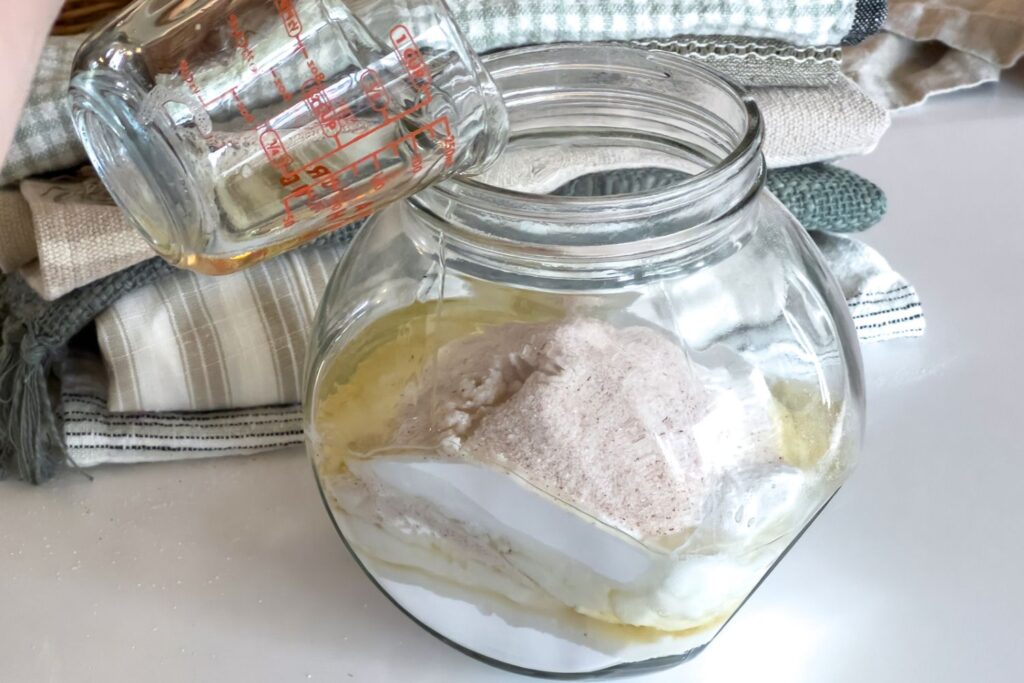
Directions
In a bowl or container, thoroughly combine the baking soda and sea salt.
Next, combine the baking soda and salt mixture with the Castile soap in the store jar. To make it easier to mix it all together, it’s best to layer the baking soda and salt mixture with part of the liquid Castile soap, and then repeat until all of the ingredients are in the jar.
Place the lid firmly on the jar, and shake vigorously to combine. The final laundry powder will be clumpy, but this is not an issue.
To use, add 1/4-1/3 cup of laundry powder to the drum of the washing machine before adding clothes and running a cycle as usual.
For an extra soiled load, add a cup of distilled white vinegar in during the rinse cycle. Do not add vinegar during the wash cycle or it will neutralize the homemade laundry detergent, making it ineffective.

Substitutions
- If you are willing to do a bit more upfront work but you do not want clumps in the final product, you may grate a bar Castile soap in the place of the liquid soap. It will work just the same, but will be easier to combine the ingredients together and will not clump in the end.
- You may use any scent of Castile soap that you like.
- If desired, you can add essential oils for added fragrance. Do your own research to insure that the oils you choose are safe for laundry and are not ones that will naturally bleach your colors over time.
Can I turn this powder laundry detergent into liquid?
If you prefer a liquid detergent to a powder, you can easily turn this homemade laundry detergent into a liquid. Simply add the powder detergent to a glass bottle, add warm filtered water, and shake until the powder dissolves into the water. Because there are no preservatives or emulsifiers in this recipe, you will need to shake the bottle of detergent each time you go to use it, and you’ll want to use it up quickly to prevent bacteria from growing.
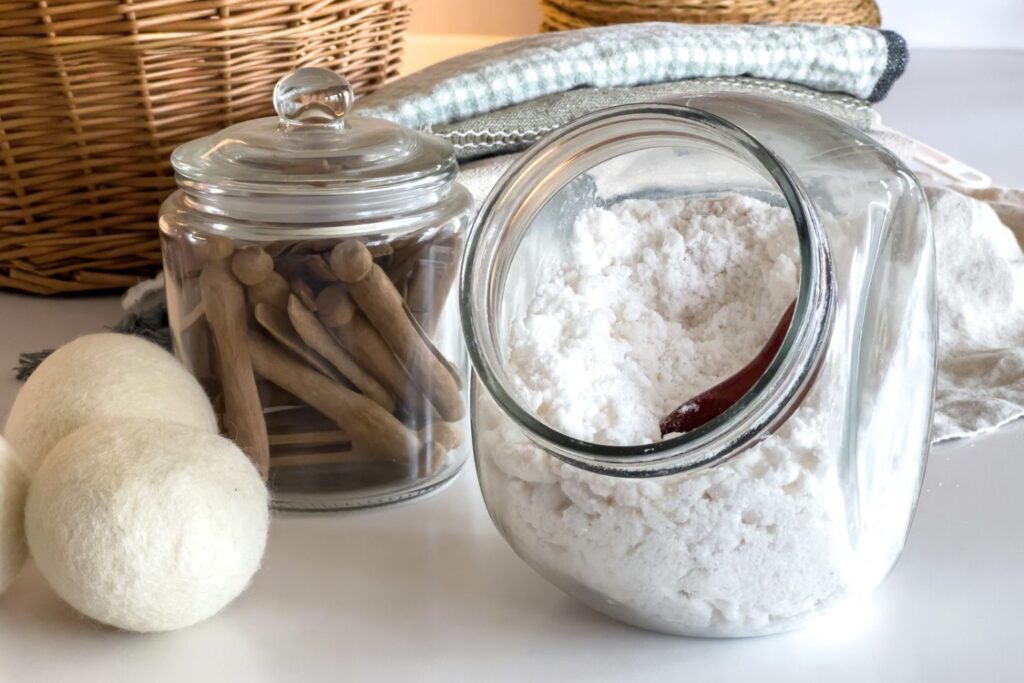
Can I hand wash clothes with homemade laundry detergent?
Yes, you can definitely hand wash clothes with this detergent, because there are no irritating ingredients to the skin in this specific recipe! Simply add about 1/2-1 tbsp. of the powder detergent to a large bowl full of water and then hand wash as usual.
Can I add essential oils to laundry detergent?
Yes, you can add essential oils to this homemade laundry detergent recipe. Just make sure that the oils you choose are not known to lighten or bleach clothes, unless you do not plan to use it for washing colored clothes.
For another wonderful laundry recipe, visit the homemade bleach alternative post!
Homemade Laundry Detergent (No Borax or Washing Soda!)
Course: Natural Food4
cups16
loadsBy far the best truly non-toxic, all-natural, and safe laundry detergent for daily use. It’s gentle on clothes, but tough on stink and stains! And unlike other recipes that call for natural but very harsh ingredients, this one is gentle enough for even baby clothes.
Ingredients
- Supplies
- Ingredients
3 cups baking soda
1/4 cup sea salt
3/4 cup liquid Castile soap (any scent)
Directions
- In a bowl or container, thoroughly combine the baking soda and sea salt.
- Next, combine the baking soda and salt mixture with the Castile soap in the store jar. To make it easier to mix it all together, it’s best to layer the mixture with the liquid soap.
- Place the lid firmly on the jar, and shake vigorously to combine. The final laundry powder will be clumpy, but this is not an issue.
- To Use: Add 1/4-1/3 cup of laundry powder to the drum of the washing machine before adding clothes and running a cycle as usual. For an extra soiled load, add a cup of distilled white vinegar in during the rinse cycle. Do not add vinegar during the wash cycle or it will neutralize the homemade laundry detergent, making it ineffective.
Notes
- If desired, you can add essential oils for added fragrance. Do your own research to insure that the oils you choose are safe for laundry and are not ones that will naturally bleach your colors over time.
More Like This…
- Homemade Stain Remover
- Non-Toxic Homemade Bleach Alternative
- Best Natural Laundry Products
- Guide to Natural Cleaning

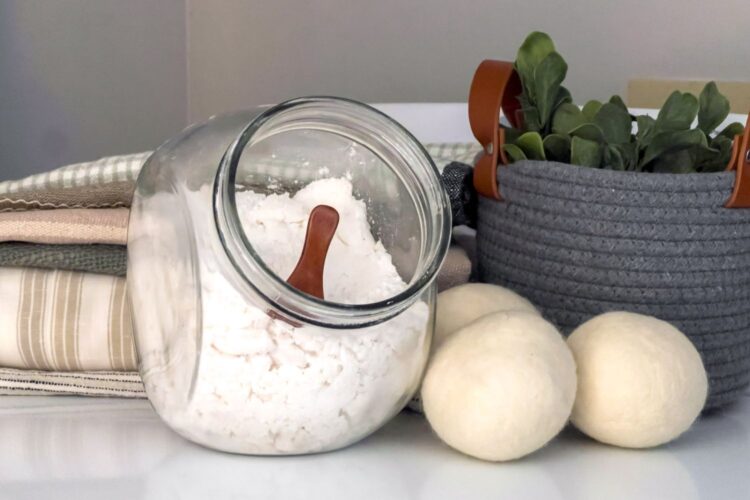
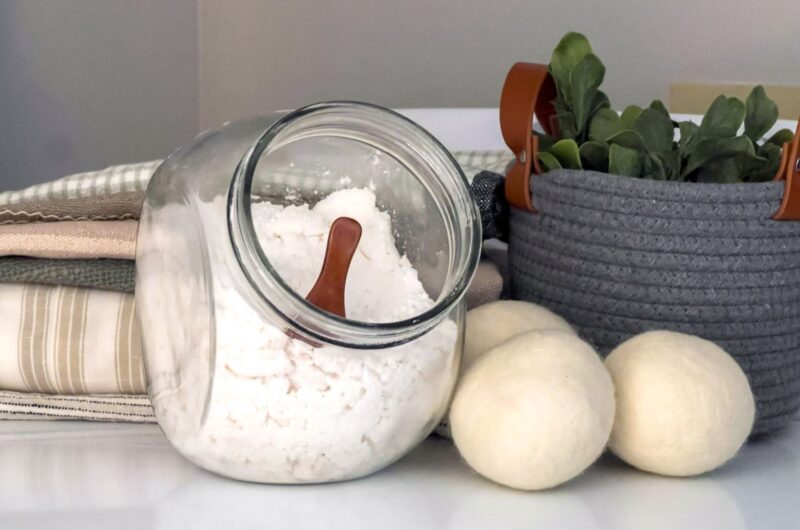

Thank you! I just made this detergent. It was very easy and my son loved helping me mix it all together. 🙂 can’t wait to wash a load
Hi! Love the recipe! If making it into liquid, how much water should I add and do I need to increase the amount I use per load?
Hey there, great question!
You can add warm distilled water, a little at a time, until you have added just enough to melt all of the ingredients into one uniform liquid. I suggest storing it in a jar that has an airtight lid so that you can shake the liquid back together between loads if it settles. And rather than using 1/4-1/3 cup per load, I would suggest using 1/3-1/2 cup per load to compensate for the added water.
Let me know what you think!